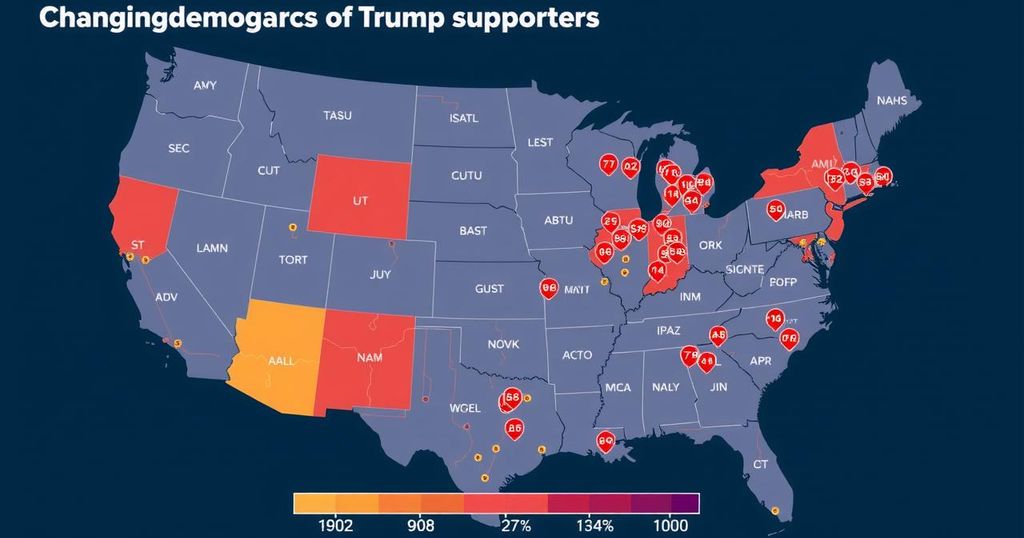Donald Trump currently leads Kamala Harris among male voters, particularly young men, with notable support from Hispanic-American and African-American demographics. Conversely, he is losing support among women, particularly white women, largely due to his past comments and policies related to gender issues and reproductive rights. This election is characterized by a growing gender gap, which may influence voter turnout and preferences significantly.
Recent polling indicates that Donald Trump enjoys a significant lead among male voters, with an advantage of 11 percentage points over Kamala Harris, according to findings from the New York Times. Trump’s support base has traditionally comprised white men, yet he has made noteworthy inroads with Hispanic-American and African-American men as well. Despite Trump’s prior derogation of Hispanics and his ongoing anti-immigrant rhetoric, half of Hispanic men reportedly regard him as sufficiently “tough” to be president. Particularly concerning the African-American demographic, approximately one in four African-American men under the age of 50 express their intention to vote for Trump, defying the conventional narrative around his divisive statements and positions. The dynamics among younger male voters reveal a significant shift, with Trump appealing to this group as they increasingly identify with Republican ideals. Notably, young men have gravitated towards conservative positions, contrasting sharply with their female counterparts, who represent the most progressive demographic to date. The gap in political alignment between young men and women has nearly doubled over the past quarter-century. Men may be attracted to Trump’s defiance against societal expectations for masculinity; a significant majority of men are inclined to feel that societal representation and value of their gender is lacking. This phenomenon has been conceptualized through the lens of fragile masculinity, suggesting that men who struggle with contemporary gender expectations may gravitate towards Trump’s assertive, and often brash, persona. This connects to his strategic portrayal of a tough masculine image, which resonates particularly well amongst his supporters. Furthermore, some men perceive an existential threat from women’s empowerment, with a notable percentage believing that the advancement of women has occurred at men’s expense. Young men, especially, exhibit significant apprehension regarding gender dynamics and the shifting balance of societal power. Conversely, Trump is not faring well with female voters, particularly white women. His past language and policies, including those related to reproductive rights, have mobilized women against him. The overturning of Roe v. Wade has intensified political engagement among female voters, significantly impacting Trump’s standing among this group. Despite his claims of being a protector of women, many female voters are disengaging from Trump’s narrative, leading to a perilous drop in his support amongst white women – from a seven-point lead in 2020 to only one point in 2024. This election cycle is characterized by a considerable gender gap, and the differing communications styles of the candidates will play a crucial role in the election’s outcome.
The 2024 US presidential election has underscored a significant shift in voter demographics, particularly among gender and racial lines. Polling data have shown that men, especially younger men, are favoring Donald Trump over Kamala Harris by a notable margin. This trend raises questions about traditional voting patterns and the implications of Trump’s framing of masculinity within a changing social landscape. In contrast, women voters, including a key demographic of white women, appear to be increasingly resistant to Trump’s candidacy, influenced by factors including reproductive rights and gender equity. The juxtaposition of support among demographics presents an intriguing narrative as the election approaches, highlighting evolving political alignments and the impact of gender on voter behavior.
In summary, the dynamics of the 2024 election illustrate a pronounced divide between male and female voters, with Trump solidifying his popularity among men, particularly young men, while losing ground with women. His appeal to masculinity and condemnation of perceived societal shifts enhances his standing among certain male voters, yet his rhetoric continues to alienate a substantial portion of the female electorate. Ultimately, the interplay of these shifting dynamics will be critical in determining the election’s outcome.
Original Source: theconversation.com






